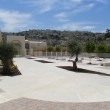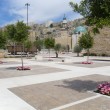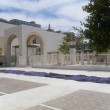About us
Introduction
The Jordan Museum ... the storyteller of Jordan
The Jordan Museum is located in the dynamic new downtown area of Ras al-‘Ayn. Presenting the history and cultural heritage of Jordan in a series of beautifully designed galleries, The Jordan Museum serves as a comprehensive national centre for learning and knowledge that reflects Jordan’s history and culture, and presents in an engaging yet educational way the Kingdom’s historic, antique and heritage property as part of the ongoing story of Jordan’s past, present, and future.
This concept is physically represented in the building’s exterior — rough and smooth stones suggest the past and present, glass the future.
Through state of the art storage and conservation practices; support of research and publications; exciting permanent and temporary exhibitions; challenging outreach programmes; and well thought out guest services, The Jordan Museum fulfills a dual role as a repository of knowledge and a centre for education, allowing it to help link Jordan with other cultures, and connecting communities within Jordan for thoughtful dialogues to help meet future challenges.
What We Do
The Jordan Museum aims to be a jumping off point for visitors to entice them to explore the cultural sites and cities in Jordan. As a museum and research center, The Jordan Museum intends to enable its guests to experience Jordanian culture and history in a lively contextual setting.
Permanent Exhibition Areas
The exhibition space encompasses much of The Jordan Museum’s 10,000 square meter building and covers 1.5 million years of Jordanian history and archaeology, starting from thePalaeolithic(Old Stone Age), linking to the present, and projecting into the future. Within three main Chronological Flow Galleries (Archaeology and History, Traditional Life, Modern Jordan), The Jordan Museum tells the ‘Story of Jordan’ both chronologically and thematically, utilizing graphics, over 2,000 artifacts on loan from the Department of Antiquities, and specially designed materials. The nine major themes elaborated on are the environment, food production and processing, visual art and architecture, cultural exchange and trade, politics and the military, communication and writing, industry, religion, and daily domestic life in Jordan throughout the ages.
Distributed among these galleries are One-to-One Theaters, thematic exhibitions that complement the chronological exhibition themes. These are the main interactive spaces in the museum that communicate Archaeology; Mining; Humans;Nomadism; Writing; Lighting; and Children of Jordan.
Other Exhibition Areas
In addition to the permanent galleries there are outdoor and temporary indoor exhibition areas. Here, on a rotating basis, the museum will offer the opportunity to explore themes in more depth usingtravellingexhibitions as well as in-house special exhibitions.
Makany
A specially planned space that contributes to our goals of education and learning. This is an inviting hands-on area devoted to teaching and learning, where children can express their creativity in projects and performing arts activities inspired by their museum visit.
Conservation Centre
An area supporting the physical sustainability of the objects of Jordan’s cultural heritage that combines cutting edge academic knowledge and facilities with practical experience and skills – a conservation center not just for Jordan, but the region.
Library
A facility including several thousand publications of largely donated materials that deal with archaeology, history, education, and museology. For the use of the museum’s staff and outside researchers.
Guest Services
The Jordan Museum will offer services to guests to enrich their visit, including a thematic gift and book shop, and a café. Spaces for private and cultural functions as well as for academic meetings and conferences are also available.
Mission & Vision
Coming soon ...
Board of Trustees
HER Majesty Queen Rania- Al-Abdullah: President
HER Royal Highness Princess Sumaya Bint El-Hassan: Vice President
H.E Ministry of Planning & International Cooperatipn
H.E Ministry of Public Works and Housing
H.E Minister of Tourism & Antiquities
H.E Minister of Culture
H.E Minister of Education
H.E Mr. Akel Biltaji
H.E Dr. Yousef Al- SHawarbeh Mayor of Amman
H.E Director General, Department of Antiquities
H.E Dr. Zeidan Kafafi
H.E Mrs. Haifa Najjar Member of Senates
H.E Mr. Khaled Masri
H.E Mr. Haitham Batikhi
H.E Jordan Museum Director General
History & Building
History
The idea of a national museum that would present the treasures of Jordan’s archeological and cultural heritage was first raised in the 1960’s. In 1980 HRH Crown Prince El Hassan bin Talal held the first International Conference on the History and Archaeology of Jordan at the University of Oxford, where conferees recommended the establishment of a “National Museum”. He founded and chaired the Society of Jordanian Culture in 1989, which worked on issues that developed into general concepts for the museum. Then in 1999 a loan agreement was signed with the Government of Japan for financing the ‘Tourism Sector Development Project’ of which a national museum was a sub-project.
In 2002 King Abdullah II bin Al-Hussein issued a royal decree stating the establishment of a “National Museum”, and accredited it by law in 2003.
The museum was brought to life on the ground in 2005, when HM Queen Rania Al-Abdullah, chair of the museum’s governing Board of Trustees, laid the cornerstone of the museum building and the Board adopted the name The Jordan Museum.
HRH Princess Sumaya bint El Hassan, vice-chair of the Board said “The Jordan museum will be a place that embodies our belief in the importance of education, learning, personal growth, and discovery. This entity will also provide an opportunity for visitors to think about the historical and cultural aspects that make up the society that surrounds them.”
Building
The chief architect of the museum building is Ja’far Toukan, a pioneering Jordanian architect and the designer of many major buildings in Jordan. He has skillfully woven the concept of the building into its very fabric, with exterior materials suggesting the past and present (rough and smooth stones) and the future (glass). The responsibility for the museum development is shared by the Ministry of Public Works and Housing, the Ministry of Tourism and Antiquities and the Greater Municipality, in collaboration with the Japanese government through JICA.
Staff Directory
International Links
Royal Ontario Museum & the Jordan Museum
The Royal Ontario Museum and the Jordan Museum are pleased to initiate this memorandum of understanding for institutional cooperation and broad-based collaboration. The Royal Ontario Museum stands as Canada’s international museum and the Jordan Museum is the premier museum of archaeology and anthropology in the Hashemite Kingdom of Jordan. Our two Museums house the great collections of our province and countries, study and protect them and display them to our citizens and to visitors from across the world.
In an effort to enhance the ways in which each of our museums fulfills its responsibility to its constituents, the Royal Ontario Museum and the Jordan Museum herby agree to work together to develop programs of benefit to both parties. We will consider such areas as developing joint research projects and the exchange of scholars, co-development and exchange of exhibitions, joint projects in the conservation of cultural property, development and exchange of educational materials for our audiences, and programs in other areas that fill the mandate described herein.
The Royal Ontario Museum and the Jordan Museum are each eager to learn from the expertise of the other. Both parties looks forward to exploring the collaborative projects described above as well as others that may arise in the spirit of friendship and open communication that typify the warm relations between our two museums and our countries.
Louvre Museum & the Jordan Museum
This Memorandum of Understanding, hereby referred to as the ‘MoU’, has been entered into force on the 14th day of October 2009, Between
The Public Establishment of the Louvre Museum,
-
Public Establishment with administrative character, bringing together the Louvre National Museum as well as the Museum Eugene Delacroix , complying with the clauses of the decree No 92- 1338 of December 22, modified registration No 180046237000012 APE925C,
Represented by his General President- Director M. Henri Loyrette
Hereinafter called the “Louvre Museum” at one hand ,
-
Jordan Museum
Represented by Dr. Faris Nimry, director General of Jordan museum,
Hereinafter called the “Jordan Museum” at the other hand
The co-signatories will be collectively referred to as the “Partie(s)”.
Preamble:
Complying with its status, the Louvre Museum’s mission is to keep, protect, restore for the account of the French state and to present to the public the works of written collections on the inventories of the Louvre National Museum and the Museum Eugene Delacroix, as well as the works placed at the Tuileries Gardens; to ensure that the public is well welcomed in both Museums and the Gardens and to develop a better attendance of the public towards the Museums, to favor their knowledge regarding their collections, to apply education actions and diffusion aiming at ensuring a legal access to the culture, for all; to ensure the scientific studies related to its collections; to join with education, research and training in the fields of history of art, archaeology and museology, in addition to auditorium management.
In order to accomplish its missions, the Louvre Museum cooperates with public rights entities, or with foreign private rights entities pursuing objectives that fulfill its purpose. The Jordan Museum is a comprehensive heritage centre for the history, civilization and culture of Jordan, a national centre of Jordan’s historic, antique and heritage property, a developing educational and touristic instrument, and a center to support authorship in the field of antiquities, heritage and modern history.
The Jordan Museum has the following aims:
-
Research and documentation of Jordan’s archeology, folklore and modern history
-
Education and information dissemination programmes to the public
-
Collection, conservation and protection of artifacts and materials
-
Exhibition, permanent or temporary, of artifacts and cultural heritage materials or Jordan.
-
Visitor services including a thematic gift shop and restaurant
This MoU is intended to encourage further connections in a certain number of common fields to both Parties that may lead to specific projects that would be covered by more formal arrangements.
The above preamble is considered an integral part of this MoU.
Objective of the MoU
The present MoY has an objective of defining the fields of cooperation between the Parties, and to determine the conditions and methods of their achievement.
The parties strive , in particular, to cooperate in the following fields:
-
Research & Education
-
Scientific & cultural projects;
-
Hosting members & staff of each other’s museums.
Other subjects and themes of cooperation could be defined jointly between the Parties. When the parties agree on a project, both will decide jointly on its operational application. The conditions and methods of application of a project will be defined, when necessary, by a special execution agreement that should be duly signed by the Parties.
It is to be determined that in all cases, the arrangements of these execution agreements should comply with the guidelines of this current MoU.
Memorandum of Agreement
Between the Jordan Museum & the Smithsonian Institution...Concerning Collaboration in Culture and Heritage Strategy and Professional development Programs
The parties intend to hold periodic discussions to consider joint programs or projects, develop plans for such joint programs or projects, and review implementation of this Agreement. Upon reaching an understanding as to the programs or projects to be undertaken by the Parties, the Parties will execute a written amendment to this Agreement (“Project Amendment”) , which specifically define such programs or projects, outlining the terms of cooperation and responsibilities for each project or activity the Parties agree to undertake.
Activities may encompass , but are not limited to:
· Collections. Programs to share collections between the Smithsonian and Jordan Museum;
· Exhibition. Opportunities to share exhibition content, including through virtual means, between the Smithsonian and Jordan Museum with the appropriate approvals for the archaeological objects (from concerned Jordanian authorities);
· Research. Programs which explore opportunities to expand joint scientific research in areas of joint mutual interest;
· Professional education and development. Programs in which the Smithsonian performs activities and advisory services related to professional education and development in managing cultural and scientific institutions. Example topics could include museum management, museum education programs, exhibition design and development, curatorial skills, collections management, visitor and community outreach services.












